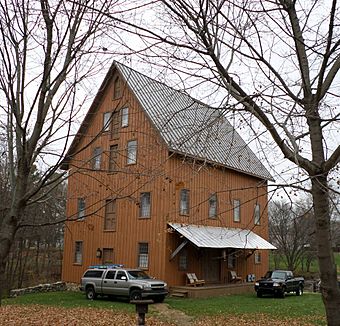Bellevue Gothic Mill facts for kids
Quick facts for kids |
|
|
Bellevue Mill
|
|
 |
|
| Location | 218 E. Mill St., Bellevue, Michigan |
|---|---|
| Area | 4 acres (1.6 ha) |
| Built | 1852 |
| Built by | Horatio Hall |
| Architectural style | Gothic Revival |
| NRHP reference No. | 75000942 |
| Added to NRHP | March 4, 1975 |
The Bellevue Gothic Mill is a historic gristmill located on the west bank of Battle Creek, at 218 East Mill Street in Bellevue, Michigan. It was listed on the National Register of Historic Places in 1975.
History
In 1832, Isaac Crary first purchased the land on which he would later plat the village of Bellevue, choosing it in part for the easy access to water power. He soon constructed the first mill in Bellevue. In 1852, Manlius Mann, from Marshall, Michigan, purchased this plot of land. He hired builder Horatio Hall to construct this gristmill as well as a sawmill. Mann continued to run the mill until 1873, when he sold it to Hiram Ovenshire and Daniel D. Gardiner. In 1881, Ovenshire bought out his partner and became the sole proprietor. Ovenshire passed the mill down to his descendants, including A.G. Butler in 1923. The Butler family ran the mill until 1958, when mill operations ceased.
After closure, the mill was used for grain storage until 1975. In 1977, the Stockhausen family purchased the property, restored the exterior, and renovated the interior for use as a private residence. The mill is occasionally open for tours.
Description
The Bellevue Gothic Mill is a three-and-one-half-story structure measuring 25 feet wide and 40 feet long, and sitting on a rubble foundation and with a gabled sheet metal roof. It is clad with a combination of tongue and groove siding and vertical board and batten siding. It is constructed from massive twelve by twelve walnut timbers and three by twelve floor joists. A loading dock was once connected to the mill but has now been removed.



